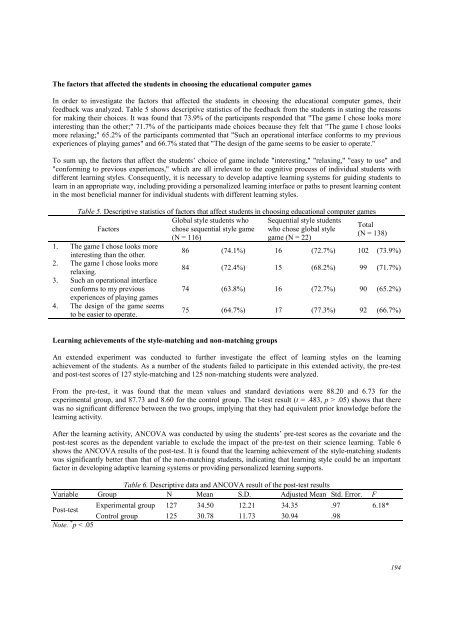Download Complete Issue in PDF - Educational Technology & Society
Download Complete Issue in PDF - Educational Technology & Society
Download Complete Issue in PDF - Educational Technology & Society
You also want an ePaper? Increase the reach of your titles
YUMPU automatically turns print PDFs into web optimized ePapers that Google loves.
The factors that affected the students <strong>in</strong> choos<strong>in</strong>g the educational computer games<br />
In order to <strong>in</strong>vestigate the factors that affected the students <strong>in</strong> choos<strong>in</strong>g the educational computer games, their<br />
feedback was analyzed. Table 5 shows descriptive statistics of the feedback from the students <strong>in</strong> stat<strong>in</strong>g the reasons<br />
for mak<strong>in</strong>g their choices. It was found that 73.9% of the participants responded that "The game I chose looks more<br />
<strong>in</strong>terest<strong>in</strong>g than the other;" 71.7% of the participants made choices because they felt that "The game I chose looks<br />
more relax<strong>in</strong>g;" 65.2% of the participants commented that "Such an operational <strong>in</strong>terface conforms to my previous<br />
experiences of play<strong>in</strong>g games" and 66.7% stated that "The design of the game seems to be easier to operate."<br />
To sum up, the factors that affect the students’ choice of game <strong>in</strong>clude "<strong>in</strong>terest<strong>in</strong>g," "relax<strong>in</strong>g," "easy to use" and<br />
"conform<strong>in</strong>g to previous experiences," which are all irrelevant to the cognitive process of <strong>in</strong>dividual students with<br />
different learn<strong>in</strong>g styles. Consequently, it is necessary to develop adaptive learn<strong>in</strong>g systems for guid<strong>in</strong>g students to<br />
learn <strong>in</strong> an appropriate way, <strong>in</strong>clud<strong>in</strong>g provid<strong>in</strong>g a personalized learn<strong>in</strong>g <strong>in</strong>terface or paths to present learn<strong>in</strong>g content<br />
<strong>in</strong> the most beneficial manner for <strong>in</strong>dividual students with different learn<strong>in</strong>g styles.<br />
Table 5. Descriptive statistics of factors that affect students <strong>in</strong> choos<strong>in</strong>g educational computer games<br />
Factors<br />
1. The game I chose looks more<br />
<strong>in</strong>terest<strong>in</strong>g than the other.<br />
2. The game I chose looks more<br />
relax<strong>in</strong>g.<br />
3. Such an operational <strong>in</strong>terface<br />
conforms to my previous<br />
experiences of play<strong>in</strong>g games<br />
4. The design of the game seems<br />
to be easier to operate.<br />
Global style students who<br />
chose sequential style game<br />
(N = 116)<br />
Learn<strong>in</strong>g achievements of the style-match<strong>in</strong>g and non-match<strong>in</strong>g groups<br />
Sequential style students<br />
who chose global style<br />
game (N = 22)<br />
Total<br />
(N = 138)<br />
86 (74.1%) 16 (72.7%) 102 (73.9%)<br />
84 (72.4%) 15 (68.2%) 99 (71.7%)<br />
74 (63.8%) 16 (72.7%) 90 (65.2%)<br />
75 (64.7%) 17 (77.3%) 92 (66.7%)<br />
An extended experiment was conducted to further <strong>in</strong>vestigate the effect of learn<strong>in</strong>g styles on the learn<strong>in</strong>g<br />
achievement of the students. As a number of the students failed to participate <strong>in</strong> this extended activity, the pre-test<br />
and post-test scores of 127 style-match<strong>in</strong>g and 125 non-match<strong>in</strong>g students were analyzed.<br />
From the pre-test, it was found that the mean values and standard deviations were 88.20 and 6.73 for the<br />
experimental group, and 87.73 and 8.60 for the control group. The t-test result (t = .483, p > .05) shows that there<br />
was no significant difference between the two groups, imply<strong>in</strong>g that they had equivalent prior knowledge before the<br />
learn<strong>in</strong>g activity.<br />
After the learn<strong>in</strong>g activity, ANCOVA was conducted by us<strong>in</strong>g the students’ pre-test scores as the covariate and the<br />
post-test scores as the dependent variable to exclude the impact of the pre-test on their science learn<strong>in</strong>g. Table 6<br />
shows the ANCOVA results of the post-test. It is found that the learn<strong>in</strong>g achievement of the style-match<strong>in</strong>g students<br />
was significantly better than that of the non-match<strong>in</strong>g students, <strong>in</strong>dicat<strong>in</strong>g that learn<strong>in</strong>g style could be an important<br />
factor <strong>in</strong> develop<strong>in</strong>g adaptive learn<strong>in</strong>g systems or provid<strong>in</strong>g personalized learn<strong>in</strong>g supports.<br />
Table 6. Descriptive data and ANCOVA result of the post-test results<br />
Variable Group N Mean S.D. Adjusted Mean Std. Error. F<br />
Post-test<br />
Note.<br />
Experimental group<br />
Control group<br />
127<br />
125<br />
34.50<br />
30.78<br />
12.21<br />
11.73<br />
34.35<br />
30.94<br />
.97<br />
.98<br />
6.18*<br />
* p < .05<br />
194

















